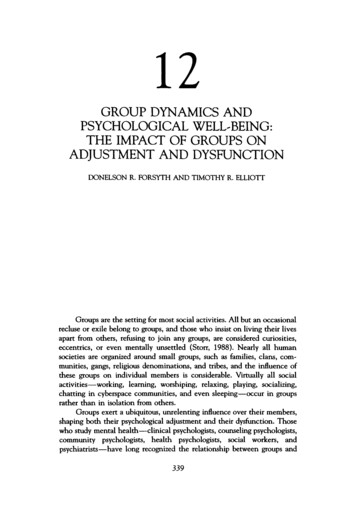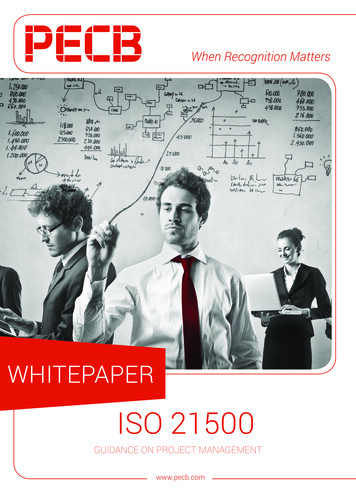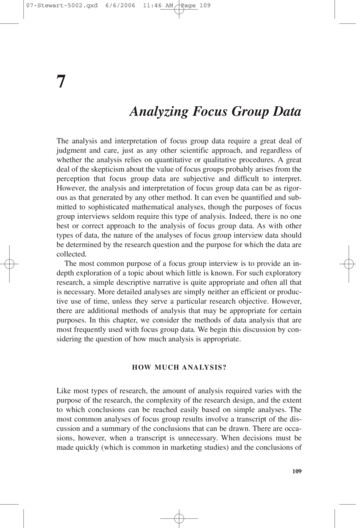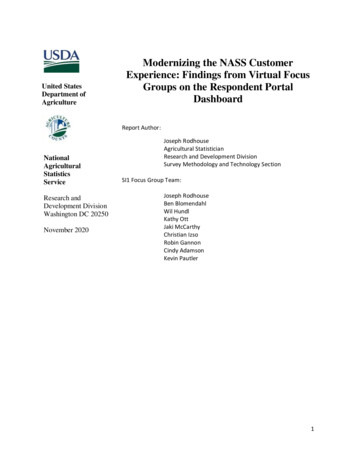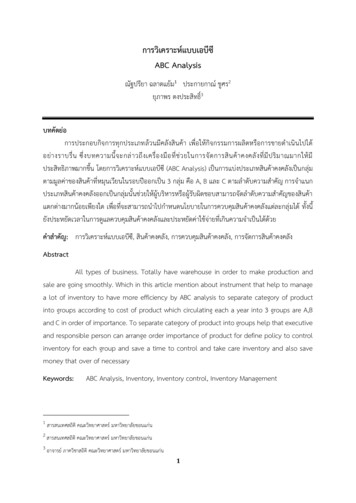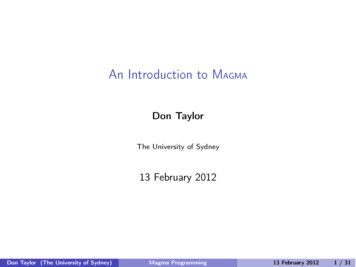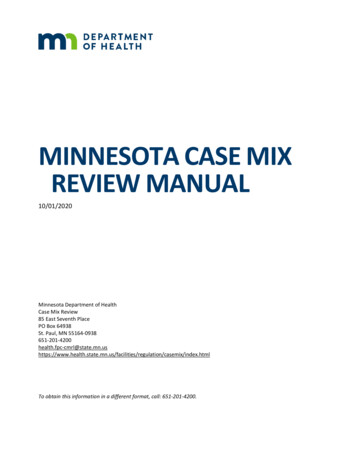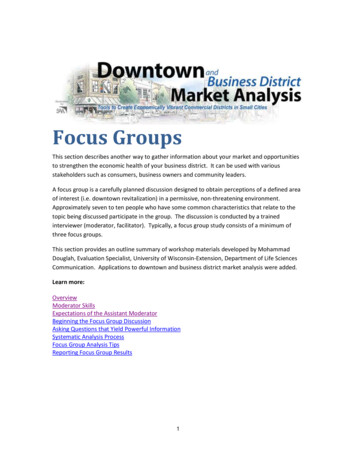
Transcription
Focus GroupsThis section describes another way to gather information about your market and opportunitiesto strengthen the economic health of your business district. It can be used with variousstakeholders such as consumers, business owners and community leaders.A focus group is a carefully planned discussion designed to obtain perceptions of a defined areaof interest (i.e. downtown revitalization) in a permissive, non-threatening environment.Approximately seven to ten people who have some common characteristics that relate to thetopic being discussed participate in the group. The discussion is conducted by a trainedinterviewer (moderator, facilitator). Typically, a focus group study consists of a minimum ofthree focus groups.This section provides an outline summary of workshop materials developed by MohammadDouglah, Evaluation Specialist, University of Wisconsin-Extension, Department of Life SciencesCommunication. Applications to downtown and business district market analysis were added.Learn more:OverviewModerator SkillsExpectations of the Assistant ModeratorBeginning the Focus Group DiscussionAsking Questions that Yield Powerful InformationSystematic Analysis ProcessFocus Group Analysis TipsReporting Focus Group Results1
OverviewWhy do Focus Groups?The focus group approach provides a qualitative alternative to survey research. It is based onthe premise that attitudes and perceptions are developed in part by interaction with otherpeople. It recognizes the danger of taking people’s perceptions for granted and provides astructure that promotes reflective thinking and self-disclosure.Examples of Downtown Focus Groups: Five stakeholder groups were used in the study ofDowntown Milwaukee as a place to live, work and recreate. These groups included: hospitalityindustry professionals, downtown workers, downtown residents, young professionals, andcollege students. Each group was asked a set of questions intended to look at various strengths,weaknesses and opportunities for improving the overall Downtown environment.When to Conduct Focus GroupsFocus groups are effective when:People have something to share (motivations)The goal is to understand human behaviorFocus groups are not effective when:People are divided or angryThe goal is to gather factual informationThe organization is trying to improve its imageSelecting ParticipantsParticipants in each focus group should be similar in terms of who they are as a group (shoppers,business operators, property owners, etc.). Ideally, participants do not know each other or themoderator. General selection rules:Set exact specificationsMaintain control of the selection processUse the resources of the sponsoring organization in recruitingBeware of bias:o Participants picked by memoryo Participants picked because they’ve expressed concerno Participants who are clones of the person doing the selectiono Participants are nonproductiveDevelop a pool of eligible participants and then randomly select those to participate Ithe focus groupSelection StrategiesList piggybackOn locationNominationsRandom phone screening2
Ads in newspapers and bulletin boardsIncentives for ParticipantsMoney (or gift certificates to downtown businesses)Food (or catered lunch)GiftsPositive, upbeat invitationSystematic Notification ProceduresSet the meeting times for interviewsContact potential participants by phone or in person (two weeks before meeting time)Send a personalized invitationPhone (or contact) each person the day before the focus group.Return to top3
Moderator SkillsSelects the right moderator:Exercise mild unobtrusive controlAdequate knowledge of topicAppears like the participantsUses an assistant moderatorHandles logisticsTakes careful notesMonitors recording equipmentIs mentally preparedAlert and free from distractionsHas the discipline of listeningMemorizes questioning routeUses purposeful small talkCreate warm and friendly environmentObserve the participants for seating arrangementsRecords the discussionTape recordersWritten notesHas a smooth & snappy introduction1.2.3.4.WelcomeOverview and topicGround rulesFirst questionUses pauses and probes5second pause"Would you explain further?" "Would you give an example?" "I don't understand."Controls reactions to participantsVerbal and nonverbalHead noddingShort verbal responses (avoid "that's good," "excellent")Uses subtle group controlExperts4
Dominant talkersShy participantsRamblersSelects appropriate locationNeutralFree from distractionsParticipants facing each otherUses appropriate three step conclusion1. Summarize with confirmation2. Review purpose and ask anything has been missed3. Thanks and dismissalReturn to top5
Expectations of the AssistantModeratorTake responsibility for equipmentEnsure that needed equipment is available and working. This includes recorders, microphone,tapes, handouts, etc.Take responsibility for refreshmentsArrange for food (either complete meals or snacks) and beverages to be available on time.Arrange the roomArrange chairs and table. Be attentive to background noises that would affect the audiorecording as well as room temperature and lighting.Welcome participants as they arriveYou are the host. Make participants feel welcome and comfortable.Sit in designated locationSit outside the circle, opposite the moderator and closest to the door. Greet those arriving lateand find them a place to sit.Take notes throughout the discussionOperate recording equipmentBe familiar with the tape recorder. Turn over or insert another tape as quietly as possible.Label the cassette tapes.Do not participate in the discussionTalk only if invited by the moderator. Control your nonverbal actions no matter how stronglyyou feel about an issue.Ask questions when invitedAt the end of the discussion the moderator will invite you to ask questions of amplification orclarification.Give an oral summaryProvide a brief oral summary (about 3 minutes). Invite participants to offer additions orcorrections to the summary.6
Thank participants and hand out the honorariums (ifapplicable)Debrief with moderatorDiscuss overall impressions, notable quotes, key ideas or insights presented, and how this groupcompared to other groups.Give feedback on analysis and reportsRead reports and provide feedback.7
Beginning the Focus Group DiscussionThe first few moments in focus group discussion are critical. In a brief time the moderator mustcreate a thoughtful, permissive atmosphere, provide the ground rules and set the tone of thediscussion. Much of the success of group interviewing can be attributed to the development ofthis open environment.The recommended pattern for introducing the group discussion includes: (1) The welcome, (2)The overview and topic, (3) The ground rules and (4) The first question. Here is an example of atypical introduction:Sample IntroductionGood afternoon and welcome to our session. Thank you for taking the time to join our discussionof how we can make downtown Milwaukee a more attractive environment for visitors. My nameis Bill Ryan and I represent University of Wisconsin-Extension. Assisting me is Judith Ruetsche, agraduate student in the Department of Urban and Regional Planning at the University ofWisconsin-Madison. We are attempting to gain information about how to improve the visitorexperience of business, convention and leisure travelers to the City. We have invited keyhospitality industry professionals who have firsthand knowledge of Milwaukee’s visitor.You were selected because you have certain things in common that are of particular interest tous. You are all employed in the hospitality industry and manage employees that come in dailycontact with visitors to Milwaukee. We are particularly interested in your views because you arerepresentative of Milwaukee’s tourism leadership.This afternoon we will be discussing ways to improve the visitor’s experience. For example, wewill identify what kinds of retail, service, dining and entertainment amenities might be missingdowntown. We will also discuss how we can more effectively market to the visitor. There are noright or wrong answers but rather differing points of view. Please feel free to share your point ofview even if it differs from what others have said.Before we begin, let me remind you of some ground rules. Please speak up, but only one personshould talk at a time. We're tape-recording the session because we don't want to miss any ofyour comments. If several are talking at the same time, the tape will get garbled and we'll missyour comments. We will be on a first name basis, and in our later reports there will not be anynames attached to comments. You may be assured of complete confidentiality. Keep in mindthat we're just as interested in negative comments as positive comments, and at times thenegative comments are the most helpful.Our session will last about an hour and a half, and we will not be taking a formal break. Well,let's begin. We've placed name cards on the table in front of you to help us remember eachother's names. Let's find out some more about each other by going around the room one at atime. Tell us your name and your work affiliation.8
Asking Questions that Yield PowerfulInformation1. Use open-ended questions2. Avoid dichotomous questionsThese are questions that can be answered with a yes or no.3. "Why?" is rarely askedCan make people defensive and that they need to provide an answerWhen you ask why, people usually respond with attributes or influences. SoIt's better to ask what prompted, or what features did you like . . .?4. Use "think back" questionsTake people back to an experience and not forward to the future.5. Carefully prepare focus questionsIdentify potential questions. There are five types of questions1.2.3.4.5.Opening Question (round robin)Introductory QuestionTransition QuestionsKey QuestionsEnding Questions6. Ask uncued questions first, cued questions secondCues are the hints or prompts that help participants recall specific features or details.7. Consider standardized questionsSentence completion, conceptual mapping8. Focus the questionsSequence that goes from general to specific9. Be cautious of serendipitous questionsConsider but be cautious of these. Often best to save for last.10. Have appropriate ending questionsAll things considered question - This question asks participants to reflect on the entirediscussion and then offer their positions or opinions on topics of central importance to9
the researchers. Example: "Of all the things we discussed, what to you is the mostimportant?"Summary question - After the brief oral summary the question asked is: "Is this anadequate summary?"Final question - The moderator reviews the purpose of the study and then asks theparticipants: "Have we missed anything?"Sample Focus Group Questions Used in MilwaukeeThe following focus group questions were designed to obtain the perceptions of severalconsumer segments that use Downtown Milwaukee as a place to live, work and recreate. Eachset of questions is intended to look at various strengths, weaknesses and opportunities forimproving the overall downtown environment. Several questions are also intended to explore theentrepreneurial environment in Downtown Milwaukee.Hospitality Industry Professionals1. Think back to a situation or situations when you have heard visitors talk about their visit toMilwaukee. What positive comments about Milwaukee do you recall?2. Think back to another situation what negative comments about Milwaukee were sharedwith you. What do you recall?3. Is there a difference between the needs of business travelers and leisure travelers? If so, howdo they differ? What kind of amenities such as specific retail services, dining andentertainment would attract more visitors/customers to downtown Milwaukee?4. Compared to other cities, what amenities do you think are missing in downtown Milwaukee;in other words, are there specific products, services or experiences that visitors/customersare repeatedly asking for?5. Are there any special services or events you offer your visitors/customers? If so, what kind?What kind of packages do you offer your customers and are they effective in improving theirexperience here in Milwaukee?6. What kind of local initiatives (in terms of products AND collaborations/network) would helpyou to improve your business?7. All things considered, if you could change one thing in Milwaukee, what would it be?10
Downtown Workers1. For a moment, think about the Greater Milwaukee area. Think about places like Brookfield,Racine, Brown Deer, New Berlin and Franklin. What do you feel are the advantages ofworking in Downtown Milwaukee compared to other surrounding communities? What aresome potential disadvantages?2. Think about other cities around the nation where you may have worked, visited, or perhapsconsidered as a place of employment. What characteristics of those cities make them moredesirable than Downtown Milwaukee as a place to work? What characteristics make themless desirable?3. In thinking about these ideal characteristics, consider the future of Downtown Milwaukee.From your perspective as a downtown employee, what could be done in DowntownMilwaukee to create your ideal workplace?4. If you were to start your own business, what advantages does Downtown Milwaukeepossess as a place to locate a business over other areas?5. What do you feel are some potential barriers to attracting new businesses into DowntownMilwaukee or retaining existing businesses?11
Downtown Residents1. For a moment, think about the Greater Milwaukee area. Think about places like Brookfield,Wauwatosa, Brown Deer, New Berlin, Mequon and Shorewood. What do you feel are theadvantages of living in Downtown Milwaukee compared to other surrounding communities?What are the disadvantages?2. Think about other downtowns around the region, state or nation where you may have lived,visited, or perhaps thought about living. What characteristics of those downtowns makethem more desirable than Milwaukee as a place to live? What characteristics make themless desirable?3. In thinking about these ideal characteristics, consider the future of Downtown Milwaukee.From your perspective as a downtown resident, what could be done in DowntownMilwaukee to create your ideal home?4. Consider the amenities present in Downtown Milwaukee. Amenities could includeentertainment and cultural venues, dining establishments, and shopping opportunities.Which amenities most contribute to your quality of life in Downtown Milwaukee? Whatadditional amenities would improve Downtown Milwaukee as a place to live?5. From your perspective as a resident, what do you feel are some potential barriers toattracting new residents into Downtown Milwaukee or retaining existing residents?12
Young Professionals1. If you were going to describe Downtown Milwaukee to a new area resident in their 20’s or30’s, what words or phrases would you use?2. From your perspective as a person in your 20’s or 30’s, what do you feel are some potentialbarriers to attracting additional young professionals into Downtown Milwaukee to work, liveor play?3. Think about other downtowns around the nation where you may have lived, worked, visited,or perhaps thought about living. What characteristics of those downtowns might makethem more desirable than Downtown Milwaukee as a place to live, work or recreate? Whatcharacteristics might make them less desirable?4. In thinking about these ideal characteristics, consider the future of Downtown Milwaukee.From your perspective as a person in your 20’s or 30’s, what steps could DowntownMilwaukee take to attract more young workers seeking social, cultural and employmentopportunities?5. Many people in their 20’s or 30’s have considered starting their own business. If you weregoing to start your own business, what aspects of Downtown Milwaukee make it a goodplace to start a business? What aspects make it less desirable?13
College Students1. New students come to Milwaukee every semester. If you were describing DowntownMilwaukee to new students, what words or phrases first come to mind?2. For a moment, think about your college experience in Milwaukee. As part of your collegeexperience, think about cultural, social and shopping opportunities in the Downtown. Howhave these opportunities in Downtown Milwaukee contributed to your overall collegeexperience?3. Think about other downtowns around the nation where you may have lived, visited, orperhaps thought about living after college. What characteristics of those cities make themmore desirable than Downtown Milwaukee as a place to live or work? What characteristicsmake them less desirable?4. As a student, consider your vision of an ideal Downtown Milwaukee for social, cultural andshopping opportunities. From your perspective as a student, what could be done to improveDowntown Milwaukee in any or all three areas?5. At some point, you will be graduating from your college. You will be faced with a choice toeither stay in the area or leave for opportunities elsewhere. What aspects of Milwaukeewould convince you to remain in the area? What aspects would influence your decision toleave?14
Systematic Analysis ProcessStart while still in the groupListen for inconsistent comments and probe for understandingListen for vague or cryptic comments and probe for understandingConsider asking each participant a final preference questionOffer a summary of key questions and seek confirmationSoon after the focus group within hours analyze individualfocus groupMake backup copy of tapes and send tape to transcriber for computer entry if transcriptis wantedAnalyst listens to tape, reviews field notes and reads transcript if availablePrepare report of the individual focus group in a question-by-question format withamplifying quotesShare report for verification with other researchers who were present at the focusgroupWithin days analyze the series of focus groupsCompare and contrast results by categories of individual focus groupsLook for emerging themes by question and then overallConstruct typologies or diagram the analysisDescribe findings and use quotes to illustrateFinally, prepare the reportConsider narrative style versus bulleted styleUse a few quotes to illustrateSequence could be question by question or by themeShare report for verification with other researchersRevise and finalize reportNote themes, hunches, interpretations and ideasCompare and contrast this focus group to other groupsLabel and file field notes, tapes and other materialsImmediately after the focus groupDraw a diagram of seating arrangementSpot check tape recording to ensure proper operationConduct moderator and assistant moderator debriefing15
Focus Group Analysis TipsConsider the wordsThink about both the actual words used by the participants and the meanings of those words. Avariety of words and phrases will be used and the analyst will need to determine the degree ofsimilarity between these responses.Consider the contextParticipant responses were triggered by a stimulus question asked by the moderator or acomment from another participant. Examine the context by finding the triggering stimulus andthen interpret the comment in light of that environment. The response is interpreted in light ofthe preceding discussion and also by the tone and intensity of the oral comment.Consider the internal consistencyParticipants in focus groups change and sometimes even reverse their positions after interactionwith others. This phenomenon rarely occurs in individual interviews due to a lack of interactionfrom other participants. When there is a shift in opinion, the researcher typically traces the flowof the conversation to determine clues that might explain the change.Consider the frequency or extensiveness of commentsSome topics are discussed by more participants (extensiveness) and also some comments aremade more often (frequency) than others. These topics could be more important or of specialinterest to participants. Also, consider what wasn't said or received limited attention. Did youexpect and not receive comments?Consider the intensity of the commentsSometimes the participants will use words that connote intensity or tell you directly about theirstrength of feeling. Intensity may be difficult to spot with transcripts alone because intensity isalso communicated by the voice tone, speed and emphasis on certain words. Individuals willdiffer on how they display strength of feeling and for some it will be a speed or excitement inthe voice whereas others will speak slowly and deliberately. One of the clues to intensity iswhen an individual varies their past speaking pattern. For example: nontalkers start speaking,slow speakers talk faster, fast talkers speak slowly, quiet speakers talk louder, etc.Consider the specificity of responsesResponses that are specific and based on experiences should be given more weight thanresponses that are vague and impersonal. To what degree can the respondent provide detailswhen asked a follow up probe? Greater attention is often placed on responses that are in thefirst person as opposed to hypothetical third person answers. For example, "I feel the new16
practice is important because I have used it and been satisfied," has more weight than, "Thesepractices are good and people in the area should use them."Find the big ideasThe researcher can get so close to a multitude of comments and details that trends or ideas thatcut across the entire discussion are missed. One of the traps of analysis is not seeing the bigideas. It may be helpful to take a few steps back from the discussions by allowing an extra dayfor the big ideas to percolate. For example, after finishing the analysis the researcher might setthe report aside for a brief period and then jot down the three or four of the most importantfindings.17
Reporting Focus Group ResultsUse a communications strategyRather than thinking of "a report," think of what type of communication strategy is needed. Avariety of reports might be used to keep people informed. Consider: email messages, postcards,phone calls, bulleted summaries, selected quotes, moderator comments, midproject or finalproject reports, personal visits by members of the research team, etc.Use an appropriate reporting style that the client findshelpful and meets expectationsAsk users what kind of report would be helpful to them. What information are they looking for?What are the expectations and traditions of reports within the organization?Strive for enlightenmentReports should raise the level of understanding of the client. The purpose is more to enlightenand convey new insights as opposed to repeating common knowledge which is already knownby the sponsor of the study.Make points memorableHelp client remember the key points by limited the number of points you highlight. Too manypoints diminish overall impact. Begin with most important points and follow with lesserimportant points.Use narrative or bulleted formatWritten reports can follow either a narrative format or a bulleted format. Don't surprise theclient with a format different from what is expected.Give thought to the oral reportOral reports should be brief, clear and concise. In addition, oral reports should allow opportunityfor questions, indicate why the study is important and why the findings are meaningful, beginwith the most important findings and engage the listener in an active manner.18
About the Toolbox and this SectionThe 2011 update of the Downtown and Business District Market Analysis toolbox is a result of acollaborative effort involving University of Minnesota Extension, Ohio State UniversityExtension, and University of Wisconsin Extension. The updated toolbox was supported withfunding from the North Central Regional Center for Rural Development.The toolbox is based on and supportive of the economic restructuring principles of the NationalTrust Main Street Center. The Wisconsin Main Street Program (Wisconsin Department ofCommerce) has been an instrumental partner in the development of this toolbox.This section was written from workshop materials developed by Mohammad Douglah,Evaluation Specialist, University of Wisconsin-Extension/Madison, Department of Life SciencesCommunication. Applications to downtown and business district market analysis were added byBill Ryan and Matt Kures of the University of Wisconsin-Extension.April 28, 201119
Phone (or contact) each person the day before the focus group. Return to top . 4 Moderator Skills Selects the right moderator: Exercise mild unobtrusive control Adequate knowledge of topic Appears like the participants Uses an assistant moderator . Ending Quest
